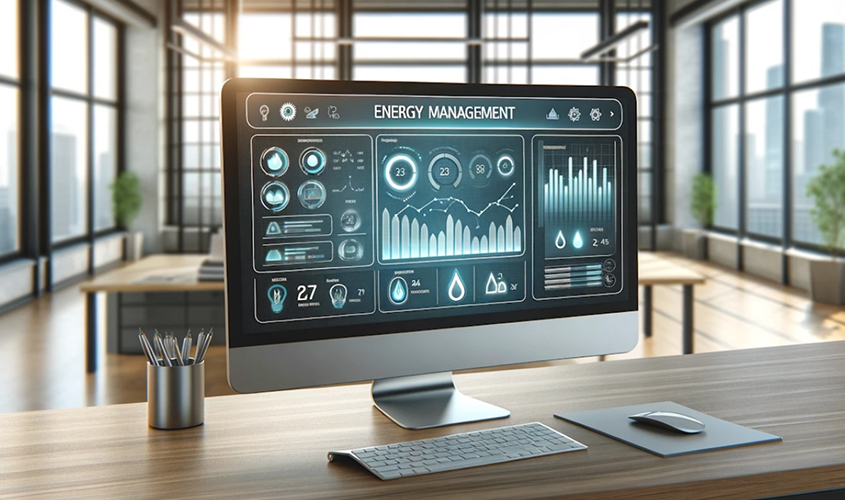In the realm of modern building management, two systems stand out for their crucial roles: Building Automation Systems (BAS) and Energy Management Systems (EMS). While both contribute significantly to building efficiency and sustainability, they serve distinct purposes and operate in unique ways. Understanding the differences between building automation and energy management systems is essential for facility managers, building owners to optimize their operations. This article delves into the key distinctions between these two systems, exploring their functionalities, objectives, and how they complement each other in creating smarter, more efficient buildings.
What is Building Automation Systems (BAS)?
1. Definition
Building Automation Systems (BAS) are centralized, interlinked networks of hardware and software that monitor and control the environment in commercial, industrial, or institutional facilities. These systems manage various building operations including heating, ventilation, and air conditioning (HVAC), lighting, security, and other systems to ensure optimal performance and efficiency.
The main purpose of BAS is to optimize building performance, ensuring a comfortable working and living environment for users, while simultaneously saving energy and operational costs.

2. Benefits
The implementation of a BAS offers numerous advantages for modern buildings:
- Centralized Control: BAS allows for the simultaneous management of multiple building systems from a single platform, simplifying operations and reducing the need for manual interventions.
- Enhanced Monitoring Capabilities: The system provides real-time data on the performance of various building components, enabling quick identification of issues and proactive maintenance.
- Improved Maintenance Scheduling: With access to detailed performance data, maintenance teams can plan and execute upkeep tasks more effectively, potentially extending the lifespan of equipment.
- Automation of Building Systems: BAS enables the automation of routine tasks and adjustments, reducing the workload on facility management staff and ensuring consistent operation.
- Optimized Comfort Control: Through automated adjustments based on predefined parameters, BAS maintains consistent comfort levels throughout the building, enhancing occupant satisfaction.
- Energy Efficiency: The system can optimize energy usage across various building systems, potentially leading to significant cost savings and reduced environmental impact.
- Increased Safety and Security: BAS can integrate with security systems, allowing for better monitoring and quicker response to potential threats or emergencies.

3. Are a BMS and a BAS the Same Thing?
In short, yes. A Building Management System (BMS) and a Building Automation System (BAS) refer to the same concept, with these terms often used interchangeably in the industry. Both describe a distributed control system that integrates multiple building systems, including HVAC, lighting, security and access control, fire safety systems, and elevators. The primary function of a BMS/BAS is to automate certain controls and settings within these systems, helping to optimize building performance, enhance occupant comfort, and improve overall efficiency.
While some industry professionals might have slight preferences for one term over the other, in practice, they denote the same type of system with identical functionalities and purposes. Understanding this equivalence is crucial when discussing building technologies, especially when comparing them to other systems like Energy Management Systems (EMS).
What are Energy Management Systems (EMS)?
1. Definition
Energy Management Systems (EMS) are sophisticated platforms designed to monitor, analyze, and optimize energy consumption and power distribution within buildings or facilities. These specialized software systems are specifically engineered to measure and manage energy usage across a building’s various systems and operations.
EMS technology collects data from multiple sources, including BMS, system equipment, utility meters, and sensors. This comprehensive data collection allows EMS to provide real-time insights into energy usage patterns, trends, and anomalies.
An EMS’s primary function is to monitor, analyze, and optimize energy consumption across a building’s systems and operations. It allows facility managers and energy specialists to centralize the tracking of energy usage, automate energy-saving strategies, and make data-driven decisions to reduce overall energy costs and improve sustainability.

2. Benefits
EMS brings to the table a range of advantages that include:
- Comprehensive Energy Tracking: EMS allows for detailed monitoring and analysis of energy consumption across all building systems, providing a holistic view of energy usage patterns.
- Real-time Data Insights: The system offers immediate access to energy consumption data, enabling quick identification of inefficiencies and anomalies for prompt action.
- Energy Savings Planning: With rich data on energy usage, managers can develop effective energy-saving strategies and measure their impact.
- Energy Consumption Optimization: EMS automatically adjusts energy usage based on actual demand, reducing waste and maximizing efficiency.
- Automated Energy Management: EMS can automatically implement energy-saving strategies based on predefined rules, reducing the workload on facility management staff.
- Improved Environmental Performance: Through reduced energy consumption, EMS significantly decreases the building’s carbon emissions, enhancing sustainability.
- Substantial Cost Savings: The system optimizes energy usage, resulting in lower utility bills and increased profits for building owners.
- Integration with Other Systems: EMS can integrate with other building management systems, allowing for a more holistic approach to building efficiency and performance.

Differences and similarities between Building Automation and Energy Management Systems
1. Similarities
Both systems aim to enhance building performance and efficiency, albeit with different primary focuses. Key similarities include:
- Data Collection: Both BAS and EMS gather and process data from various building systems and sensors, providing valuable insights into building operations.
- Real-time Monitoring: These systems offer real-time monitoring capabilities, allowing facility managers to track building performance and identify issues promptly.
- Automation: Both systems incorporate automation features to optimize building operations without constant manual intervention.
- Sustainability Benefits: Implementation of either system can result in significant energy savings and a reduced environmental impact.
2. Differences between Building Automation and Energy Management Systems
| Aspect | Building Automation Systems (BAS) | Energy Management Systems (EMS) |
| Main Function | Control, Automation (DO, ACT) | Monitoring, Analysis (PLAN, CHECK) |
| Primary Focus | Overall building operations and comfort | Energy consumption and optimization |
| Scope | Controls multiple building systems (HVAC, lighting, plumbing, security, etc.) | Primarily focuses on energy-consuming systems |
| Main Purpose | Keep occupants comfortable and streamline daily operations jobs of engineers and building operators | Provide visibility and deep insights into energy use, analyze energy consumption patterns to forecast future needs, uncover savings opportunities, and mitigate cost-increase risks. |
| Optimization | Focuses on equipment efficiency | Emphasizes overall energy use patterns and strategies |
| Installation | Often requires cost-intensive retrofits and equipment installations | Can be standalone or integrated with BAS without invasive installations |
| Cost Implications | Higher upfront costs for equipment and installation | Lower implementation costs, focuses on optimization |
| Adaptability | Less adaptable, focused on preset controls | More adaptable, can adjust based on analytical insights |
| Impact on Operations | Automates control but may not provide guidance on optimal operational strategies | Transforms energy optimization metrics into simple, actionable initiatives |
BAS vs. EMS: Do Buildings Need Both?
As building energy management continues to grow in significance, business owners often find themselves pondering a crucial question: Does my building need both a Building Automation System (BAS) and an Energy Management System (EMS)?
A BAS focuses on centralized management and control of building systems, while an EMS specializes in optimizing energy efficiency. At first glance, these might seem like overlapping functions, but in reality, they complement each other beautifully.
But does every building need both systems? The answer depends on your specific goals and requirements. For instance, if your building is located in a city with carbon drawdown laws, like Ha Noi or Ho Chi Minh City, the combined capabilities of BAS and EMS could be invaluable in meeting stringent energy efficiency targets.
The integration of BAS and EMS, along with other technological aids, creates a powerful toolkit for reducing energy consumption and environmental impact. This approach allows building managers to gain deeper insights into building performance, implement more effective energy-saving strategies, respond quickly to changing conditions, and achieve higher levels of sustainability and operational efficiency.
While not every building may require both systems, their combination offers a comprehensive solution for those seeking to maximize energy efficiency and meet ambitious environmental goals. In an increasingly eco-conscious world, the question might not be whether you need both systems, but rather, can you afford not to have them?
Ultimately, the decision to implement both BAS and EMS should align with your building’s specific needs, environmental commitments, and long-term efficiency goals. As we continue to prioritize sustainable building practices, the integration of these systems may become not just a luxury, but a necessity for forward-thinking business owners and managers.
At Vinergy, we don’t just provide solutions; we partner with our customers throughout the implementation and operation process, ensuring optimal efficiency for each project. To learn more about how Vinergy can help your building achieve optimal energy efficiency through the integration of BMS and EMS, don’t hesitate to get in touch with us!
